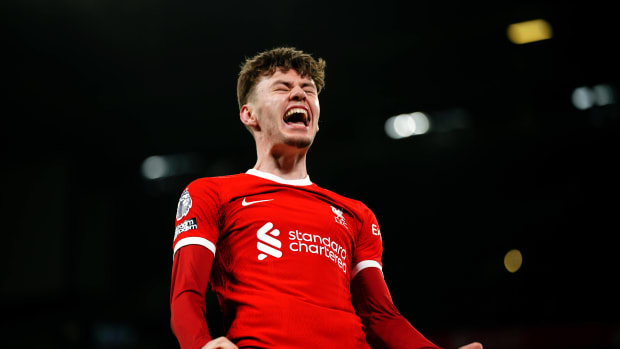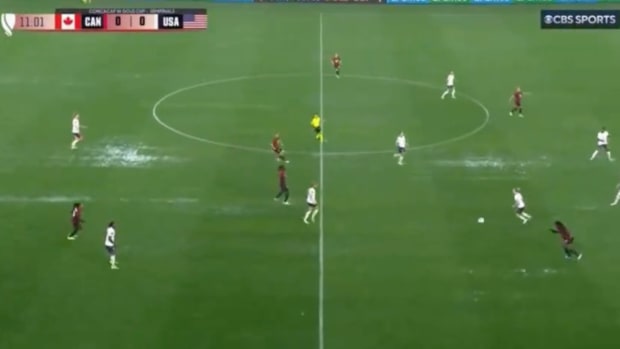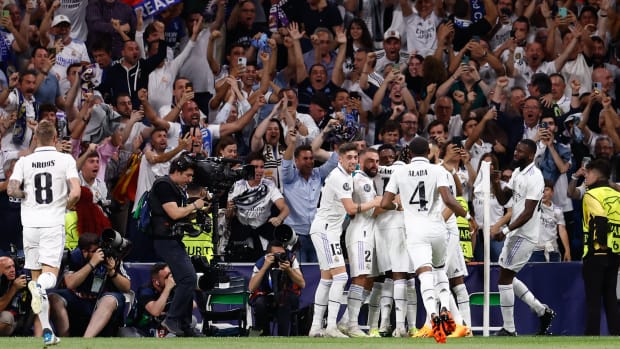The USWNT Cannot Strike and More Revelations From Latest U.S. Soccer Lawsuit Filings
With a May 5 trial date looming, the class action lawsuit brought by members of the U.S. women’s national team against U.S. Soccer has entered an important pretrial phase: each side has filed for summary judgment.
Late Thursday, the two sides combined to file 144 documents, totaling over 1,000 pages, in the U.S District Court for the Central District of California. They hope to persuade Judge Gary Klausner to rule on key issues before the trial begins. The 78-year-old judge, who earned a Bronze Star for his service as a United States Army captain in the Vietnam War and whom President George W. Bush nominated to the bench in 2002, will hold a hearing on the summary judgment motions in his Los Angeles courtroom on March 30. On one hand, there's the U.S. women, who are seeking over $66 million in damages. On the other extreme is U.S. Soccer, which is seeking to have the case dismissed altogether.
Meanwhile, documents contained within the flurry of filings include a copy of the collective bargaining agreement for the women’s team. This is the first time the CBA, which runs from Jan. 1, 2017 through Dec. 31, 2021, has been made public. Article 26 of the CBA is significant: it prevents the players from going on strike at any time while the CBA is in effect. This means the players can’t use the threat or actuality of striking prior to the 2020 Olympic Summer Games in Tokyo (Jul 24 – Aug. 9) as bargaining leverage with U.S. Soccer.
Here's a closer look at what the filings from each side mean, the biggest revelations to emanate from them and what it all means in the grander context of this lawsuit:
Understanding summary judgment as it relates to the class action lawsuit
Summary judgment is appropriate when there is no dispute about key facts related to all or part of a lawsuit and, when applying those facts to a legal issue, the judge determines how that issue must be resolved. In assessing a motion for summary judgment, the judge considers the pleadings and evidence that have been provided by the parties.
In this litigation, much of the evidence contains witness statements and empirical data. The evidence is driven by dueling witnesses, who possess varying types of knowledge, expertise and impressions. They have offered competing analysis on the pay and compensation for two sets of soccer players—the women and men who play for their respective U.S. national teams. If Judge Klausner concludes there is no genuine issue of material fact with respect to aspects of the litigation and that one side is entitled to judgment as a matter of law, he will grant summary judgment.
Judges are often reluctant to grant summary judgment and need to be thoroughly convinced to grant it. The granting of summary judgment denies jurors of an opportunity to consider the case as a whole or, if partial summary judgment is granted, part of the case. In assessing a motion for summary judgment, judges review the evidence in the most favorable light to the side that opposes the motion. In other words, if the women players assert that there is no genuine dispute as to a particular set of facts and if U.S. Soccer disagrees with that assertion, Judge Klausner will consider the applicable facts in the most favorable light to U.S. Soccer.
Breaking down the players’ key arguments
The players—led by their four class representatives, Alex Morgan, Megan Rapinoe, Becky Sauerbrunn, and Carli Lloyd—seek a partial summary judgment. This means they still intend to go to trial on May 5 but would like Judge Klausner to resolve certain aspects of the case prior to the trial.
The players’ brief in support of the motion, which was obtained by SI.com, is authored by one of their lead attorneys, Jeffrey Kessler of Winston & Strawn. Kessler is a prominent sports attorney. He has litigated on behalf of the National Basketball Players’ Association, the National Football League Players’ Association, Tom Brady, Bill Belichick and other high-profile sports figures.
Through Kessler, the players maintain that summary judgment is appropriate because of what they call the “undisputed fact” of illegal wage discrimination. In sum, the players assert that after 11 months of litigation, U.S. Soccer has failed to offer a believable reason why, other than because of their gender, women players are paid less than their male counterparts for sufficiently similar work.
The players detail this argument in part by revisiting the question of whether U.S. Soccer violated the Equal Pay Act, which makes it illegal for employers to discriminate employees’ pay on the basis of gender and other demographic characteristics. The players maintain that “there is no genuine issue of material fact that U.S. Soccer has violated the Equal Pay Act by discriminating against the WNT players in their rate of pay for substantially similar work.”
To advance this argument, the players highlight an undisputed fact: the collective bargaining agreements for the men’s team and women’s team contemplate different compensation policies. Players on the men’s team are paid through lucrative bonuses but earn fewer guarantees. In contrast, players on the women’s team are compensated through more guarantees but with less upside.
Where Judge Klausner will observe disagreement between the sides is why the two teams use very different pay schemes.
As told by Kessler, players on the women’s team and their union, the USWNT Players’ Association, repeatedly demanded a system of compensation that would be equivalent to the one used for players on the men’s team. U.S. Soccer, Kessler writes, rejected such demands and refused to entertain systems that would have provided equal pay. Along those lines, Kessler writes U.S. Soccer, “never offered the WNT the same level of game bonuses that the MNT players have the opportunity to receive under their CBA.” Kessler concedes that U.S. Soccer did offer a “pay to play” model to the women’s team, but it was (in his view) an inferior design: it allegedly lacked equal bonuses for friendlies and also denied an equal rate of pay for participation on the World Cup and other tournament events.
Kessler also incorporates statements by U.S. Soccer witnesses that express how the CBA for the women’s team contemplates lower pre-game bonuses and other compensation. Likewise, Kessler flags public statements by U.S. Soccer president Carlos Cordeiro who has admitted in statements to the public that players on the women’s team “have not been treated equally.” Cordeiro also testified and shared similar concerns.
Remarks by former U.S. Soccer president Sunil Gulati are also highlighted by Kessler. Gulati, according to Kessler, has admitted in testimony that pay differences between the team are justified because—as worded mostly by Kessler, not Gulati—“of gender differences in ‘speed’ and ‘strength.’” Kessler maintains that a less favorable attitude toward women players begins to tell the story as to why U.S. Soccer tries to negotiate inferior terms for the women’s team.
Kessler then attempts to reject assertions by U.S. Soccer that discrimination is disproven by virtue of women’s players earning more in total compensation. This finding, Kessler explains, reflects the fact that the women’s team won more games and has been much more successful than the men’s team.
In that same light, and as Judge Klausner has observed, discrimination isn’t determined (or disproven) by total remuneration. It’s determined by rate of pay for work performed. A person who works twice as many hours might earn more than a person who works half as many hours but the harder worker could still be paid less per hour. In addition, the women’s players compensation reflects some of them having a second job in soccer—playing for teams in the National Women’s Soccer League, which U.S. Soccer manages but is a separate pro league. “Simply put,” Kessler writes, “the Equal Pay Act does not require a woman to work two jobs to receive what a man can earn for working one.”
Kessler then turns to asserting that there are no credible factual disputes over whether players on the women’s team and men’s team perform “equal work.” The Equal Pay Act defines “equal work” as work that is substantively equal as to effort, skill and responsibility. Notice the word “substantively”—the work does not need to be identical or entirely alike.
In addition, there are three elements to proving “substantial equality with respect to equal work. Those three elements are skill, effort and responsibility.
Kessler cites testimony from coaches and other witnesses that players on both teams are equally skilled “in each key area of soccer.” Applicable key areas are identified as: (1) athleticism, (2) tactical IQ, (3) tactical proficiency and (4) mental fortitude. While pointedly noting that the women’s team has been “much more successful” than the men’s team, Kessler contends that evidence and testimony show the two teams are sufficiently equal in terms of skill.
Likewise, Kessler maintains the teams are substantially equal with respect to effort, which is defined by federal statute as meaning “the amount of the amount of physical or mental exertion needed to perform a job.” Cordeiro, Gulati and former USWNT head coach Jill Ellis stressed in testimony that the players on both teams work very hard.
Lastly, with respect to determining “substantial equality,” Kessler tackles the element of responsibility. Under applicable law, responsibility refers to the degree of accountability in performing a job. Kessler draws Judge Klausner’s attention to the fact that Jay Berhalter, the outgoing chief operating officer for U.S. Soccer, testified that the responsibilities of both teams are similar. Such similarities are expressed in each team’s CBA.
To that end, players on both teams must maintain a high level of competitive soccer skills, must remain in exceptional physical condition and must not use drugs and banned substances. Both teams also “play under the same rules, on the same sized fields, and work and practice equally as hard.” Their off-the-field duties, meanwhile “are similar as well, including media appearances.”
Kessler also rejects arguments by U.S. Soccer that the two teams don’t perform equal work because they play different opponents, compete in different tournaments and face players with varying skill sets and talents. Kessler claims that precedent on that matter is on his side. He cites an Equal Pay Act case, Marcoux v. Maine, which involved female prison guards in Maine who sued over being paid less than male prison guards. The two sets of guards worked at different correctional facilities. The court—the U.S. Court of Appeals for the First Circuit, which governs federal cases in four of the six New England states along with Puerto Rico and is persuasive, but not binding, authority over California federal cases—held that the work was substantially equal.
Kessler also attempts to convince Judge Klausner by highlighting employment situations outside of sports. He cites salespersons as an example. “Female salespersons selling the same products as male salespersons,” Kessler stresses, “would not have to show that they travel to the same clients in the same geographic regions in order to assert an Equal Pay Act claim for being paid less than the men.”
Further, Kessler attempts to debunk defenses raised by U.S. Soccer. A key defense is that the union for the women’s players agreed to the terms that they now challenge. Kessler insists that this defense misses the point. The women’s players, Kessler maintains, only agreed to accept what he portrays as inferior terms because U.S. Soccer wouldn’t offer more. Kessler also cites a provision within the Equal Pay Act that bluntly states that “collective bargaining agreements are not a defense” and that “any and all provisions in a collective bargaining agreement which provide unequal rates of pay in conflict with the requirements of the EPA are null and void and of no effect.”
Kessler is likely dismissive of U.S. Soccer maintaining that the men’s team has generated more revenue, net profits and broadcasting ratings. Kessler cites evidence produced during the litigation that he maintains shows the women’s team “generated more game-related revenue and earned more net profits during the class period.” He further notes that it is often not possible to attribute revenue generated to one of the two teams since U.S. Soccer and its sponsors jointly market both teams. That said, Kessler insists that empirical evidence raised during the trial makes clear that “when not counting the broadcasting and sponsorship revenues that cannot be allocated,” the women’s team generated $85 million from April 1, 2015 through September 30, 2019 whereas the men’s team only generated $76 million during that same period.
The latter part of Kessler’s brief concerns claims under Title VII of the Civil Rights Act of 1964. Title VII is very similar to the Equal Pay Act. Both make it illegal for employers to pay workers differently on the basis of their sex. Both also permit the employer to establish that differences in pay between male and female worker might reflect lawful reasons, such as pay discrepancies resulting from a seniority system (often a feature of a unionized workplace), a merit system or pay based on production. The arguments raised with respect to Title VII are similar to the ones described above for the Equal Pay Act.
Breaking down U.S. Soccer’s key arguments
Like players on the women’s team, U.S. Soccer seeks to convince Judge Klausner to find there are no genuine issues of fact and that jurors aren’t needed to debate those facts. The difference is that U.S. Soccer’s portrayal of the facts (and accompanying legal reasoning) is completely different.
Like the players, U.S. Soccer filed a brief accompanied by numerous supporting documents, including transcripts and letters. The brief, which was obtained by SI.com, is authored by attorney Brian Stolzenbach of Seyfarth Shaw, a law firm retained by U.S. Soccer for this litigation.
Stolzenbach begins the brief with acknowledgment of the “public narrative” surrounding the lawsuit. This is an obvious reference to the substantial criticism U.S. Soccer has faced with respect to pay for women's players—particularly as they won the Women's World Cup for a fourth time. This line of criticism has been mentioned by presidential candidates, among other influential persons.
Stolzenbach asks Judge Klausner—who as a federal judge has a lifetime appointment and thus shouldn’t be swayed by popular sentiment—to render his judgment “based on the actual facts.” Stolzenbach insists these “actual facts” tell “a much different story” than what the public has been led to believe by media and social media influencers who seem inclined to support the players. Stolzenbach requests that Judge Klausner dismiss the entire lawsuit on summary judgment, meaning the case would be over before a trial takes place.
The U.S. Soccer brief stresses that player compensation and benefits are determined through a collective bargaining process, “during which the players are represented by the WNTPA, a union the players organized to represent themselves (and only themselves).” While Kessler asserts that U.S. Soccer rejected the desire of the women’s players to be compensated similarly to the men’s team, Stolzenbach maintains “the WNTPA consistently demanded a very different collective bargaining agreement from the one covering players on the [men’s team].”
Without saying so, Stolzenbach implies that to the extent players on the women’s team are unhappy with their CBA, they ought to retain new labor negotiators or a form a different union. The players blaming U.S Soccer, which is on the management side of the bargaining table and which represents the interests of the employer, for terms negotiated by the union could be perceived as blaming the wrong party.
Stolzenbach also maintains that the women’s team obtained benefits that the men’s team lacks. Those benefits include:
· Six-figure salaries paid to WNT players independent of whether they actually play, including guaranteed salary continuation during periods of injury.
· Free medical insurance.
· Paid child care assistance.
· Paid pregnancy and parental leave.
· Severance benefits.
· Access to a retirement plan.
· Three “partnership” bonuses (tied to television ratings, sponsorship revenue, and ticket sales); more than $1 million annually to cover players’ salaries while playing in the NWSL.
· A $230,000 signing bonus paid directly to 23 players.
· An annual $350,000 payment to the union in exchange for certain rights to use the players’ likenesses.
As Stolzenbach tells it, “the end result is this: U.S. Soccer paid the WNT far more than the MNT over the past five calendar years. Between the beginning of 2015 and the end of 2019, U.S. Soccer paid the WNT players and their union more than $37 million [whereas] the corresponding figure for the MNT is just north of $21 million.”
He further stresses that even if Judge Klausner sets aside (1) all money paid to players in the form of NWSL salaries and (2) all the money the players have directed to their union instead of themselves, “U.S. Soccer still has paid the WNT $6 million more than the MNT over that same period.” He also argues that, “even controlling for the number of games each team has played, U.S. Soccer still has paid the WNT more than the MNT on a per-game basis.”
In other words, the empirical data offered by Stolzenbach completely contradicts the empirical data provided by Kessler. If Judge Klausner believes that both sides offer plausible, but contradictory, calculations, he’ll be inclined to deny both sides’ motions for summary judgment and let the jury decide. Remember, summary judgment is only appropriate when the key facts aren’t in dispute (among other relevant factors that will sway a judge).
Stolzenbach also warns Judge Klausner of what he sees as precedential dangers should he rule for the players. “It would contravene the law,” Stolzenbach writes, for the court to “retroactively and selectively rewrite the plaintiff’s CBA to give them the benefit of the high reward, while also keeping all the other unique advantages of their agreement, when they never took the higher risk.” This assertion reflects, as discussed above, how the unions for the two teams negotiated different CBAs. The players on the men’s team obtained a lower amount of guaranteed pay but the opportunity for higher bonuses while the reverse proved true for players on the women’s team.
Stolzenbach maintains it would contravene core principles of labor law for a jury or judge to effectively alter a CBA to give one side more benefits after the fact. Unions and management would be less inclined to negotiate a CBA if it could later be altered by a court. While a court ruling that U.S. Soccer broke the law and owes millions of damages–over $66 million is what is being demanded–to the players would not directly change the CBA, it would almost certainly necessitate changes in order the bargaining relationship to continue.
Stolzenbach also rejects Kessler’s depiction of the players on both teams performing the substantively same jobs. He cites a statement by player/plaintiff Kelley O’Hara, who, as worded by Stolzenbach conveyed during a deposition that “it is not sex discrimination for U.S. Soccer to pay her more than it pays men who compete in the Olympics” because—and here are O’Hara’s own words— “it’s a completely different tournament for the men and the women.”
Stolzenbach also rejects the popular narrative that U.S. Soccer is obligated to pay the women players the same amount for winning the Women’s World Cup that the men’s team would have been paid if they won the World Cup. These two tournaments, Stolzenbach maintains, are completely different. The qualifying process for the men’s tournament, as noted by Stolzenbach, requires three times as many games and travel to Mexico, Central America and the Caribbean over a period of several months. In contrast, he writes, the qualifying process for the women’s team is a two-week tournament “entirely on home turf.” Stolzenbach also places emphasis on the fact that “there are 25% more teams in the men’s tournament” and over a billion people watch it on TV. In addition, FIFA, which hosts the tournament, pays the men’s players much more because of global revenue generation and is the organization that sets World Cup prize money figures.
Stolzenbach maintains that the players on the women’s team have not been paid less, by any defensible metric, and that competition for the women’s team and men’s team is differently structured. Moreover, to the extent there are compensation differences, Stolzenbach repeatedly reminds Judge Klausner that the players union negotiated those differences.
To that point, Stolzenbach tells a very different history of events that led to collectively bargained terms. He claims that during negotiations for the 2013-2016 CBA (which is no longer in effect but which no doubt influenced the terms of the current CBA), the WNTPA “never asked for the compensation terms it now wants the Court to impose on U.S. Soccer.” He writes that the union did seek a number of terms, including fixed salaries, salary for playing in the women’s pro league, insurance benefits and childcare assistance and the union got all of those demands from U.S. Soccer. Any pay differences between the two teams, Stolzenbach writes “is indisputably the result of the collective bargaining process, not sex discrimination.”
Next steps: a hearing, possible trial but no strike
In their briefs, both sides offer compelling legal arguments and raise detailed factual assertions that contradict the other side. This is a recipe for Judge Klausner to deny both sides’ motions for summary judgment or, in the alternative, only grant partial summary judgment. It will be interesting to see how the attorneys argue their points in court when they appear before Judge Klausner on March 30. Chances are, he will greenlight the start of the trial for May 5 and let the jury hear from all involved, including the players.
One thing is for sure: the players will not have any leverage from the threat of a strike before the Olympics. Article 26 of the CBA extinguishes that risk for U.S. Soccer, which in retrospect appears very wise to have demanded the term be in the CBA.
Michael McCann is SI’s Legal Analyst. He is also an attorney and Director of the Sports and Entertainment Law Institute at the University of New Hampshire Franklin Pierce School of Law.







